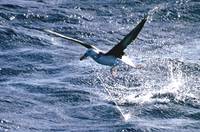|
Alex Aitken, a snapper fisherman from Leigh, New Zealand, and Peter Robinson, a tuna fisherman from Newcastle, Australia, have shared the €18,000 first prize in an international fishing competition organised by SEO/BirdLife (BirdLife in Spain) to encourage fishermen to design ways to stop seabirds being killed during longline fishing operations. They independently submitted the same idea of dripping fish liver grease onto the water behind vessels as they are bait-setting.
Aitkin explains, "I used to catch about 100 seabirds per year until I discovered that birds avoided the grease on the water's surface. That, plus using a bird scaring streamer line during setting operations has reduced my seabird by-catch to around five birds per year and means that I can set my lines during daytime without birds getting tangled in them."
"The winning idea is simple, cheap, easy to use and totally effective in the tests that we have carried out." —Carles Carboneras, Seabird Conservation Officer, BirdLife International
The grease is obtained from the livers of fish that would otherwise be discarded overboard. Fish livers are mashed and ground up to obtain a greasy paste. A small amount is enough, as a slick soon forms astern of the vessel, acting as a deterrent and keeping the birds well away.
"We still don't know exactly how it works, but there's something in it that keeps birds off – they probably do not to like to soak their plumage in the grease... What there's no doubt about is that it is very effective. However, we must be careful and make sure it doesn't have any negative effects, so we invite all fishermen to test the idea and to tell us their experiences," says Carles Carboneras, BirdLife's Seabird Conservation Officer.
The competition, which was supported by Spanish savings bank, Caixa Galicia, and Spain's Ministry of Agriculture, Fisheries and Food, received 87 entries from 11 countries including Spain, New Zealand, Australia, USA, Ecuador and Uruguay, and was judged by an international panel of 12 fishing and seabird conservation experts.
Meanwhile, in Brazil, experiments by Tatiana Neves of Projeto Albatroz with blue-dyed bait are proving very successful, both in keeping seabirds off the hook and in increasing the overall catch of fish.
Neves explains, "It has been known for some time that birds ignore bait that has been dyed blue. However, in Brazil we have been experimenting with dye that has two components – one water soluble, the other silvery in tone and fat soluble. The former quickly leaches away, leaving the bait silvery-blue in colour and making it more attractive to the fish the vessels are targeting."
BirdLife is now working with fishermen around the world to encourage the use of simple, effective measures, like those above, to help bring to an end the needless destruction of the world's seabirds.
Recipe for fish liver grease
To make the grease, take out the livers and other greasy parts from the viscera of the fish (tuna, anchovy, shark, snapper, among many species) and mash them to form a paste. Add salt and store in a drum for 3-5 days. To dispose, drill a hole through the tap, turn the drum sideways and place on a side of the vessel or at the stern. Allow the grease to drip slowly as the vessel progresses during setting. A greasy slick soon forms astern of the vessel, as a film that changes the surface tension of the water, which is enough to keep the birds away. Overall consumption is 2-3 litres for 1000 hooks. The grease can be made on board. For total effectivity, the use of this grease should be combined with that of a standard streamer line.
Top
|
